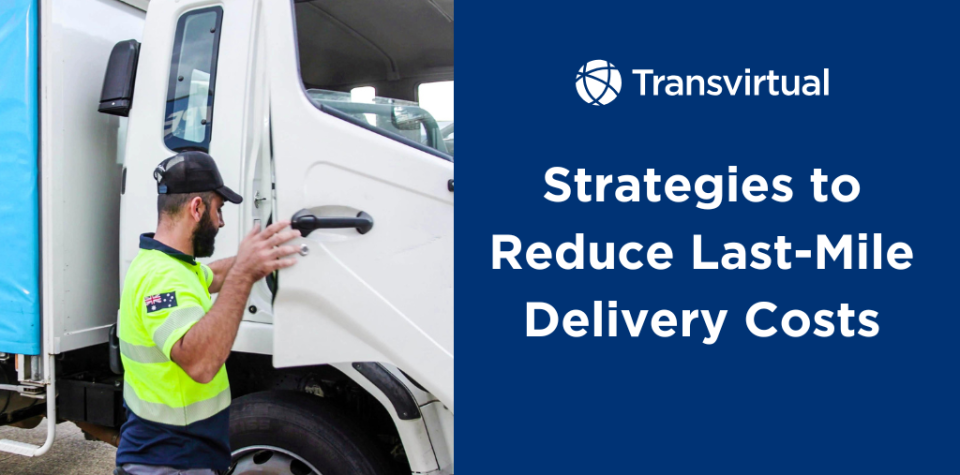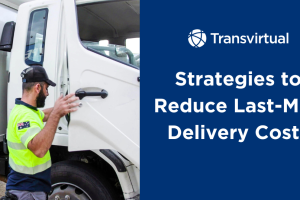Table of Contents
The ‘last mile’ of a delivery journey, when an item travels from a transport hub to its final destination, is a particularly costly and challenging part of the delivery process.
Delivery drivers play a key role in ensuring timely and accurate deliveries during the last-mile stage. This article explores the costs involved in last-mile delivery and offers strategies to reduce them. Since last-mile delivery often represents a significant portion of total shipping costs, optimizing it can greatly improve both operational efficiency and profitability.
Why are last mile delivery costs so expensive?
Last mile delivery is fundamentally different to each other leg of the shipping journey: in other stages, there is only a single, or very limited number of destinations for the freight at the end of the journey.
In Last Mile Delivery, a large number of deliveries to different locations are typically pooled together within a truck or car. Companies are also potentially dealing with hundreds or thousands of packages every day. This means that last mile delivery requires multiple, frequent stops along the course of a route rather than a continuous journey to one destination.
Last mile delivery costs can account for up to 53% of total shipping expenses, making it a significant contributor to overall shipping costs.
The problem comes in when you realise that with each extra stop comes the potential for increased permutations of route and logistical troubles. Multiply this by the number of packages in a truck and a larger issue becomes apparent. With so many opportunities for the journey to veer off course, there becomes very little guarantee of efficiency on the journey.
Main factors driving up delivery costs
1. Failed delivery attempts
Failed deliveries are a unique challenge in last-mile delivery compared to other stages of the logistics journey. Drivers often face issues like missed delivery windows, customers not being home, or customers being unaware of their delivery status. These factors frequently lead to failed connections with recipients. On average, around 5% of deliveries fail, causing wasted labor and fuel on unnecessary or repeated trips.
2. Fuel costs & surcharges
Last mile delivery, particularly in urban areas, requires driving at low speeds with frequent acceleration and breaking, or even hours spent idling in city traffic. These actions are far more fuel consumptive and expensive than coasting along a freeway, and making it difficult to estimate costs. Additionally, last mile delivery services can significantly impact fuel costs and surcharges due to the increased demand for fast and reliable deliveries.
3. Route deviations
Route deviations can quickly rack up costs associated with ‘out of route miles’ – that is, the fuel cost associated with travelling further than or alternatively to a planned route. While a surface level solution is simply to enforce that drivers stick to their intended route.
Without a GPS system connected to advanced route management software, it becomes necessary for drivers to go off-route when they come across challenges such as roadwork or heavy traffic delays. The problem with this is that it can lead to unexpected costs, because the planned route is no longer a good indication of how much fuel was used in the journey.
3 ways to reduce costs of Last Mile Delivery
1. Route Optimisation & Integrated GPS
Intelligent routing and logistics software can significantly boost efficiency in last mile operations.
By leveraging route optimisation software, you can simplify complex tasks, eliminate human error, and reduce admin time. The result? Efficient delivery routes that minimize delays, cut fuel consumption, and save costs from unnecessary idling and traffic hold-ups. TLDR: You reduce your last mile costs by a ton!
A transport management system that allows drivers to easily access this information is also crucial. After all, there’s no point having a perfectly planned route if the driver isn’t aware of its existence. Integrating different elements of the system together – particularly the route planning software and the GPS and navigation system available to drivers. This means that drivers are better able to stick to their routes and avoid creating out-of-route mile costs.
2. Advanced Track and Trace
Seamless communication with both drivers and customers can help to drastically reduce the cost and inefficiencies of the last mile.
Advanced Track and Trace empowers customers to monitor their delivery status online and receive real-time updates. This enhanced transparency improves communication, reduces delivery failures, and allows customers to plan their availability for receiving goods. It also supports delivery drivers by providing efficient route management tools, ensuring timely and accurate deliveries.
3. Reducing Labour
Labour is one of the most expensive aspects of the last mile delivery process. Now, a certain amount of labour is of course necessary to complete the delivery, but many companies bleed revenue through poor labour management. This is either by way of excessive admin time spent manually planning out routes and dispatch, or overscheduled drivers who are left with nothing to do.
Reducing labor can significantly impact last mile delivery costs, which often account for up to 53% of total shipping expenses.
A comprehensive TMS is able to not only reduce administrative labour costs by automating a number of administrative functions such as routing, dispatching, and invoicing. This enables more efficient scheduling by centralizing all relevant information in a single system.
Enhancing Customer Experience and Satisfaction
Enhancing customer experience and satisfaction is crucial in last mile delivery. With the rise of e-commerce and same-day delivery, customers expect fast, reliable, and convenient delivery options. To meet these expectations, businesses can implement various strategies to enhance the customer experience.
One effective strategy is to provide real-time tracking and updates. By keeping customers informed about the status of their deliveries, businesses can reduce anxiety and improve satisfaction. Additionally, offering flexible delivery options, such as choosing specific delivery windows or locations, can cater to individual customer needs and preferences.
Proactive communication is another key element. Sending notifications about delivery times, delays, or any issues that may arise ensures that customers are always in the loop. This transparency not only builds trust but also reduces the likelihood of failed deliveries.
By leveraging technology and focusing on customer-centric practices, businesses can significantly enhance the customer experience in last mile delivery, leading to higher satisfaction and loyalty.
Sustainable Practices in Last Mile Delivery
Sustainable practices in last-mile delivery are gaining importance as businesses work to reduce their environmental impact.
Customers increasingly value eco-friendly options, pushing companies to adopt measures like using electric delivery vehicles, consolidating shipments, and optimizing routes to minimize fuel use. These practices not only lower emissions but also align with customer expectations.
One approach to sustainability is the use of eco-friendly delivery vehicles, such as electric or hybrid vehicles. These vehicles produce fewer emissions compared to traditional gasoline-powered ones, helping to reduce the carbon footprint of last mile deliveries.
Optimizing delivery routes is another effective strategy. By using advanced route planning software, businesses can minimize the distance traveled and fuel consumed, leading to lower emissions and operational costs. Additionally, consolidating deliveries to reduce the number of trips can further enhance efficiency and sustainability.
Reducing packaging waste is also crucial. Businesses can adopt eco-friendly packaging materials and practices, such as using recyclable or biodegradable materials and minimizing excess packaging. This not only benefits the environment but also appeals to environmentally conscious customers.
By implementing these sustainable practices, businesses can contribute to a greener future while also improving their operational efficiency and customer satisfaction.
Last Mile Delivery tracking & automation
Last mile delivery is challenging and unpredictable by nature, which drives up costs exponentially. However, it can be more easily and cost effectively managed through a TMS software. It has the capacity to respond seamlessly to quick logistical changes and automate administrative tasks. Reducing last mile delivery costs through tracking and automation is essential for enhancing profitability and operational efficiency.
Emerging Trends Shaping the Cost of Last Mile Delivery
Technology is transforming the future of last-mile delivery. Innovations like AI, real-time tracking, and automation are helping businesses reduce total supply chain costs and improve delivery accuracy.
As customer expectations grow for faster, more transparent services, these technologies also help companies meet demands while staying efficient and cost-effective.
Autonomous vehicles are another promising innovation. Self-driving delivery vehicles can operate around the clock without the need for breaks, increasing delivery efficiency and reducing labor costs. As technology advances, these vehicles are expected to become more prevalent in last mile delivery operations.
By staying informed about these future trends and embracing new technologies, businesses can ensure they remain competitive and meet the evolving demands of last mile delivery.
Want to get started with route optimisation, track and trace, and scheduling options? Book a free demo with Transvirtual today or get in touch with our team for a chat.



